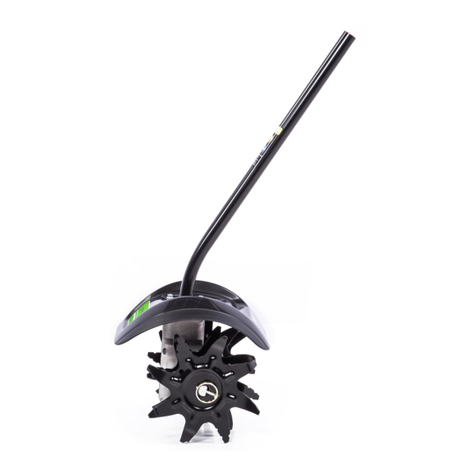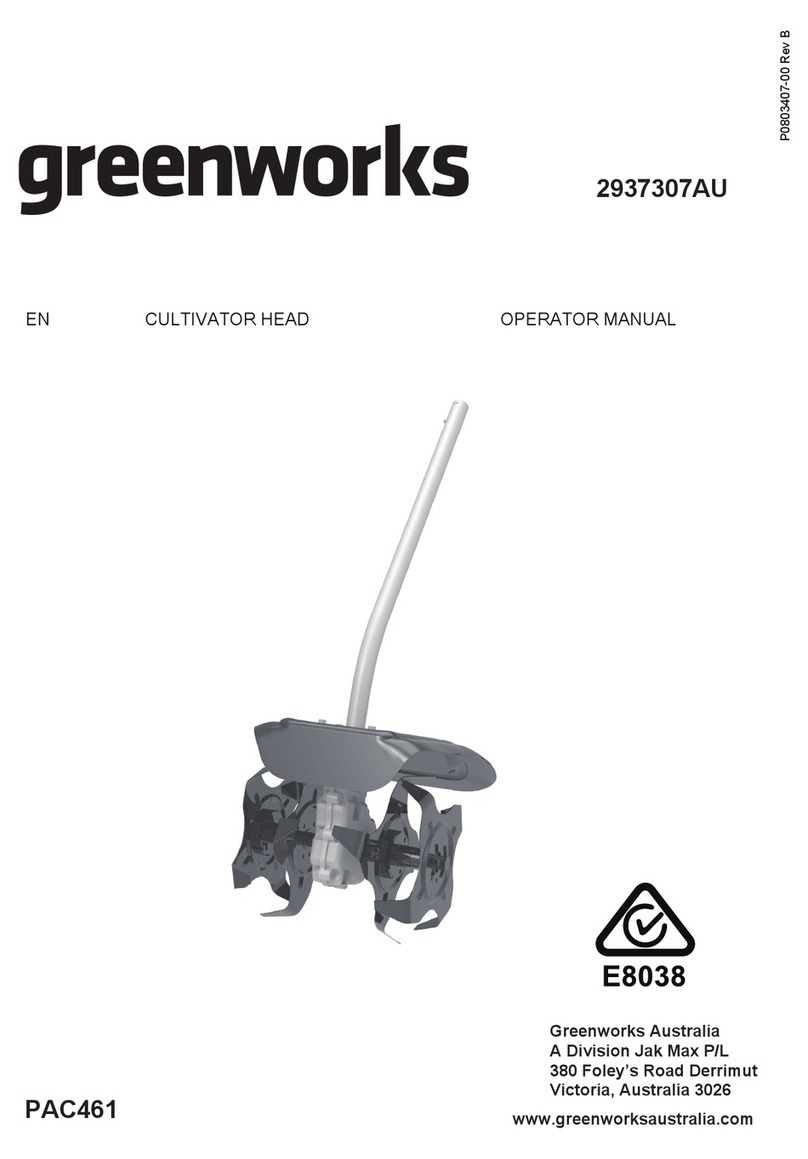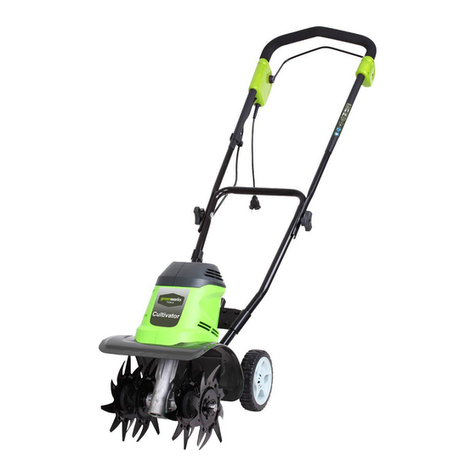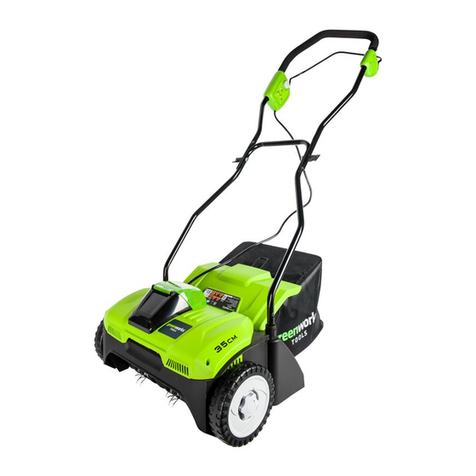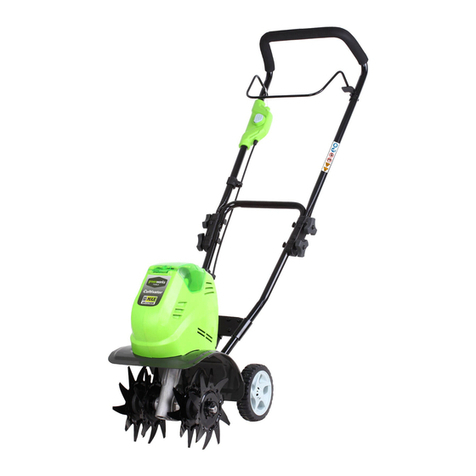
6. Den äußeren Hackstern A auf die rechte Seite der
Hacksternwelle legen. Die Seite mit der Prägung sollte in
Richtung Hackstern B zeigen.
7. Um die Hacksterne an der Hacksternwelle zu befestigen,
stecken Sie die Ringstifte in die Löcher auf beiden Seiten
der Hacksternwelle.
HINWEIS
Bei falscher Montage der Hacksterne funktioniert das Gerät
nicht einwandfrei. Wenn Sie ein Problem mit dem
Kultivierungsbetrieb des Gerätes feststellen, überprüfen Sie
die korrekte Positionierung der Hacksterne.
WARNUNG
Die Hacksterne und die Maschine können beschädigt
werden, auch wenn Sie die Maschine bei ausgeschaltetem
Motor bewegen. Um zu verhindern, dass die Hacksterne
während der Fahrt den Boden berühren, kippen Sie die
Maschine bitte.
4 ANWENDUNGEN
• Auflockern von Gartenerde zur Vorbereitung des
Saatbeetes für die Pflanzung.
• Flache Bodenbearbeitung, um Unkraut zu entfernen.
4.1 MASCHINE STARTEN
Abbildung 4.
1. Schließen Sie die Maschine an ein für den Außenbereich
zugelassenes Verlängerungskabel an.
2. Drücken und halten Sie die Sicherheitssperrtaste.
3. Ziehen Sie den Bügelschalter in Richtung Griff, während
Sie die Taste für die Sicherheitssperrtaste gedrückt halten.
4. Lassen Sie die Sicherheitssperrtaste los.
WARNUNG
Halten Sie die Maschine im laufenden Betrieb mit beiden
Händen fest.
HINWEIS
Stellen Sie sich hinter die Maschine, mit den Hacksternen
auf dem Boden und dem Arbeitsbereich sauber und frei von
Hindernissen.
4.2 MASCHINE ANHALTEN
Abbildung 4.
1. Den Bügelschalter loslassen, um die Maschine
anzuhalten.
4.3 SCHMALE
BEARBEITUNGSBREITE
Die beiden äußeren Hacksterne können entfernt werden, um
eine schmalere Bearbeitungsbreite zu ermöglichen.
1. Entfernen Sie die Ringstifte aus den Bohrungen an den
Enden der Hacksternwelle.
2. Entfernen Sie die äußeren Hacksterne und Filze von der
Hacksternwelle.
3. Setzen Sie die Anhängestifte in die Löcher ein.
4.4 TIPPS ZUR BEDIENUNG
Mit dem Kultivator können Sie Gartenerde auflockern und
ein Saatbeet für die Pflanzung vorbereiten. Denken Sie daran,
genügend Platz zwischen den Saatreihen zu lassen, damit eine
maschinelle Bearbeitung nach dem Wachstum der Pflanzen
möglich ist.
1. Es können mehrere Durchläufe über dieselbe Bahn
erforderlich sein, um die gewünschte Tiefe zu erreichen.
Versuchen Sie nicht, im ersten Durchgang zu tief zu
graben.
2. Wenn die Maschine springt oder bockt, lassen Sie die
Einheit etwas schneller vorwärts fahren oder installieren
Sie den Radsatz.
3. Wenn der Kultivator an einer Stelle bleibt und sich
eingräbt, versuchen Sie, ihn durch seitliches Hin- und
Herschaukeln wieder in Bewegung zu setzen.
4. Wenn der Boden sehr hart ist, gießen Sie ihn einige Tage
vor der Bearbeitung. Vermeiden Sie es, den Boden bei
Nässe oder Feuchtigkeit zu bearbeiten. Warten Sie ein
oder zwei Tage nach starkem Regen, bis der Boden
trocken ist.
5. Flache Bodenbearbeitung mit einer Tiefe von weniger als
5 cm kann dazu eingesetzt werden, um Unkraut zu
zerstören und den Boden zu belüften, ohne die
nahegelegenen Pflanzenwurzeln zu verletzen. Dies sollte
häufig durchgeführt werden, damit das Unkraut nicht zu
groß wird und sich in den Hacksternen des Gerätes
verfängt.
5 WARTUNG UND
INSTANDHALTUNG
VORSICHT
Lassen Sie Bremsflüssigkeiten, Benzin und
mineralölbasierte Materialien nicht mit den Kunststoffteilen
in Berührung kommen. Chemikalien können den Kunststoff
beschädigen und ihn unbrauchbar machen.
VORSICHT
Verwenden Sie keine starken Lösungsmittel oder
Reinigungsmittel auf dem Kunststoffgehäuse oder den
Bauteilen.
WARNUNG
Nehmen Sie den Akkupack vor der Wartung aus der
Maschine.
10
Deutsch
DE
